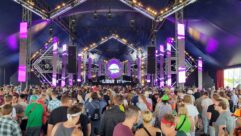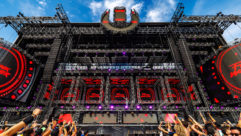The Solar Stage
Energy prices are a major concern these days for concert producers, who are responsible for transporting a village of people and AV equipment from city to city. So, they’re turning their focus to conservation and the use of alternative energy sources.
The 30-amp limit applied to anything audio-related, including the main PA, front-of-house mix position, backline, and stage monitors. For a stage of the tour’s size, it’s not uncommon to specify 100 amps or more. The team used a pair of Lab.Gruppen fP10000Q 4-channel amplifiers, which continuously draw 10-12 amps with a real music signal. Because the amplifiers employ one less power supply and one less chassis to get four channels, there was less overall weight and power draw. Using two amplifiers, the team was able to power a main PA of eight EAW KF730 loudspeakers and four BH760 horn-loaded subwoofers.
Six EAW NT56 self-powered speakers, drawing 1.5 amps each, served as stage monitors, coupled with two EAW NTS22 subwoofers. In all, the monitor rig consumed 12 amps. For further efficiency, the FOH mix position also ran the monitor mix on a Mackie TT24 digital console that drew about 2 amps, meaning five monitor mixes and the FOH mix were handled by one mixing console rather than two.
For Tom McNabb, FOH engineer for the stage, introducing solar power didn’t affect his job. “I was skeptical when I was first asked to work on a solar-powered stage,” he says. “But it is a very transparent system; the stage is totally mobile and self-sufficient.”
Up to 60 days of performance information was stored in the charger. Once a week, McNabb sent the information to Allyn, who kept tabs on the stage’s real-world operation. “The propane generator has not been turned on once this tour,” adds Chris Anderson, the solar stage’s stage tech. “At its lowest point, we had 82 percent of power left after two days of rain.”
Allyn says no special training was required to operate the stage. IT was pulled by a semi, like a standard mobile stage, with the only difference being the overall weight. “It is a bit heavier due to the solar rig. The solar batteries are bigger than car battery (70-plus pounds each) so Department of Transportation weight limits may affect the number of batteries you can carry,” he explains.
Is the stage a sign of things to come? As the audio industry moves toward lightweight products that consume less power, it could. Says EAW’s Rich Frembes, who worked with Allyn on the project, “Similar to how advances in DSP technology are shaping our industry, advances in solar power and energy efficiency will too.”










